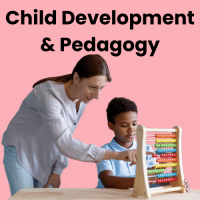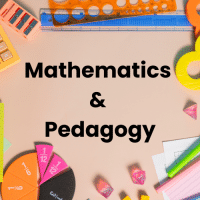CTET & State TET Exam > CTET & State TET Questions > Given below are two statements, one labeled a...
Start Learning for Free
Given below are two statements, one labeled as Assertion A) and the other labeled as Reason R). Read the statements and choose the correct answer using the code given below.
Assertion A): In an inclusive classroom, close-ended questions should be asked to foster the creativity of children.
Reason R): Close-ended questions give students the opportunity to elaborate their point of view as they have more than one correct answer.
Assertion A): In an inclusive classroom, close-ended questions should be asked to foster the creativity of children.
Reason R): Close-ended questions give students the opportunity to elaborate their point of view as they have more than one correct answer.
- a)Both (A) and (R) are true
- b)Both (A) and (R) are false
- c)(A) is true, but (R) is false
- d)(A) is false, but (R) is true
Correct answer is option 'B'. Can you explain this answer?
| FREE This question is part of | Download PDF Attempt this Test |
Most Upvoted Answer
Given below are two statements, one labeled as Assertion A) and the ot...
An inclusive classroom includes each and every category of children in the educational system, regardless of their differences and disabilities. In an inclusive classroom, all creative, gifted, intelligent, backward, mentally retarded children study together.
- Creativity is a cognitive ability to produce something original by offering a fresh perspective. It is the ability possessed by people who are creative, persistent, and imaginative.
Free Test
FREE
| Start Free Test |
Community Answer
Given below are two statements, one labeled as Assertion A) and the ot...
Explanation:
Assertion A: In an inclusive classroom, close-ended questions should be asked to foster the creativity of children.
Reason R: Close-ended questions give students the opportunity to elaborate their point of view as they have more than one correct answer.
The correct answer is option B: Both (A) and (R) are false.
Explanation:
Assertion A: In an inclusive classroom, close-ended questions should be asked to foster the creativity of children.
This statement is not true. In an inclusive classroom, open-ended questions are generally encouraged to foster the creativity of children. Open-ended questions allow students to think critically, express their thoughts, and explore different perspectives. These types of questions promote higher-order thinking skills and encourage students to come up with their own ideas and solutions. Close-ended questions, on the other hand, often have one correct answer and limit the opportunities for students to think creatively.
Reason R: Close-ended questions give students the opportunity to elaborate their point of view as they have more than one correct answer.
This statement is also not true. Close-ended questions typically have one correct answer or a limited set of predetermined answers. They do not provide students with the opportunity to elaborate their point of view or express their thoughts in a meaningful way. Open-ended questions, on the other hand, allow for multiple perspectives and encourage students to think critically, analyze information, and support their ideas with evidence.
In conclusion, both the assertion and reason given in the question are false. In an inclusive classroom, open-ended questions are preferred to foster creativity and critical thinking skills among students. Close-ended questions, on the other hand, have limited value in promoting creativity and may restrict students' ability to express their thoughts and ideas.
Assertion A: In an inclusive classroom, close-ended questions should be asked to foster the creativity of children.
Reason R: Close-ended questions give students the opportunity to elaborate their point of view as they have more than one correct answer.
The correct answer is option B: Both (A) and (R) are false.
Explanation:
Assertion A: In an inclusive classroom, close-ended questions should be asked to foster the creativity of children.
This statement is not true. In an inclusive classroom, open-ended questions are generally encouraged to foster the creativity of children. Open-ended questions allow students to think critically, express their thoughts, and explore different perspectives. These types of questions promote higher-order thinking skills and encourage students to come up with their own ideas and solutions. Close-ended questions, on the other hand, often have one correct answer and limit the opportunities for students to think creatively.
Reason R: Close-ended questions give students the opportunity to elaborate their point of view as they have more than one correct answer.
This statement is also not true. Close-ended questions typically have one correct answer or a limited set of predetermined answers. They do not provide students with the opportunity to elaborate their point of view or express their thoughts in a meaningful way. Open-ended questions, on the other hand, allow for multiple perspectives and encourage students to think critically, analyze information, and support their ideas with evidence.
In conclusion, both the assertion and reason given in the question are false. In an inclusive classroom, open-ended questions are preferred to foster creativity and critical thinking skills among students. Close-ended questions, on the other hand, have limited value in promoting creativity and may restrict students' ability to express their thoughts and ideas.
Attention CTET & State TET Students!
To make sure you are not studying endlessly, EduRev has designed CTET & State TET study material, with Structured Courses, Videos, & Test Series. Plus get personalized analysis, doubt solving and improvement plans to achieve a great score in CTET & State TET.

|
Explore Courses for CTET & State TET exam
|

|
Similar CTET & State TET Doubts
Given below are two statements, one labeled as Assertion A) and the other labeled as Reason R). Read the statements and choose the correct answer using the code given below.Assertion A): In an inclusive classroom, close-ended questions should be asked to foster the creativity of children.Reason R): Close-ended questions give students the opportunity to elaborate their point of view as they have more than one correct answer.a)Both (A) and (R) are trueb)Both (A) and (R) are falsec)(A) is true, but (R) is falsed)(A) is false, but (R) is trueCorrect answer is option 'B'. Can you explain this answer?
Question Description
Given below are two statements, one labeled as Assertion A) and the other labeled as Reason R). Read the statements and choose the correct answer using the code given below.Assertion A): In an inclusive classroom, close-ended questions should be asked to foster the creativity of children.Reason R): Close-ended questions give students the opportunity to elaborate their point of view as they have more than one correct answer.a)Both (A) and (R) are trueb)Both (A) and (R) are falsec)(A) is true, but (R) is falsed)(A) is false, but (R) is trueCorrect answer is option 'B'. Can you explain this answer? for CTET & State TET 2024 is part of CTET & State TET preparation. The Question and answers have been prepared according to the CTET & State TET exam syllabus. Information about Given below are two statements, one labeled as Assertion A) and the other labeled as Reason R). Read the statements and choose the correct answer using the code given below.Assertion A): In an inclusive classroom, close-ended questions should be asked to foster the creativity of children.Reason R): Close-ended questions give students the opportunity to elaborate their point of view as they have more than one correct answer.a)Both (A) and (R) are trueb)Both (A) and (R) are falsec)(A) is true, but (R) is falsed)(A) is false, but (R) is trueCorrect answer is option 'B'. Can you explain this answer? covers all topics & solutions for CTET & State TET 2024 Exam. Find important definitions, questions, meanings, examples, exercises and tests below for Given below are two statements, one labeled as Assertion A) and the other labeled as Reason R). Read the statements and choose the correct answer using the code given below.Assertion A): In an inclusive classroom, close-ended questions should be asked to foster the creativity of children.Reason R): Close-ended questions give students the opportunity to elaborate their point of view as they have more than one correct answer.a)Both (A) and (R) are trueb)Both (A) and (R) are falsec)(A) is true, but (R) is falsed)(A) is false, but (R) is trueCorrect answer is option 'B'. Can you explain this answer?.
Given below are two statements, one labeled as Assertion A) and the other labeled as Reason R). Read the statements and choose the correct answer using the code given below.Assertion A): In an inclusive classroom, close-ended questions should be asked to foster the creativity of children.Reason R): Close-ended questions give students the opportunity to elaborate their point of view as they have more than one correct answer.a)Both (A) and (R) are trueb)Both (A) and (R) are falsec)(A) is true, but (R) is falsed)(A) is false, but (R) is trueCorrect answer is option 'B'. Can you explain this answer? for CTET & State TET 2024 is part of CTET & State TET preparation. The Question and answers have been prepared according to the CTET & State TET exam syllabus. Information about Given below are two statements, one labeled as Assertion A) and the other labeled as Reason R). Read the statements and choose the correct answer using the code given below.Assertion A): In an inclusive classroom, close-ended questions should be asked to foster the creativity of children.Reason R): Close-ended questions give students the opportunity to elaborate their point of view as they have more than one correct answer.a)Both (A) and (R) are trueb)Both (A) and (R) are falsec)(A) is true, but (R) is falsed)(A) is false, but (R) is trueCorrect answer is option 'B'. Can you explain this answer? covers all topics & solutions for CTET & State TET 2024 Exam. Find important definitions, questions, meanings, examples, exercises and tests below for Given below are two statements, one labeled as Assertion A) and the other labeled as Reason R). Read the statements and choose the correct answer using the code given below.Assertion A): In an inclusive classroom, close-ended questions should be asked to foster the creativity of children.Reason R): Close-ended questions give students the opportunity to elaborate their point of view as they have more than one correct answer.a)Both (A) and (R) are trueb)Both (A) and (R) are falsec)(A) is true, but (R) is falsed)(A) is false, but (R) is trueCorrect answer is option 'B'. Can you explain this answer?.
Solutions for Given below are two statements, one labeled as Assertion A) and the other labeled as Reason R). Read the statements and choose the correct answer using the code given below.Assertion A): In an inclusive classroom, close-ended questions should be asked to foster the creativity of children.Reason R): Close-ended questions give students the opportunity to elaborate their point of view as they have more than one correct answer.a)Both (A) and (R) are trueb)Both (A) and (R) are falsec)(A) is true, but (R) is falsed)(A) is false, but (R) is trueCorrect answer is option 'B'. Can you explain this answer? in English & in Hindi are available as part of our courses for CTET & State TET.
Download more important topics, notes, lectures and mock test series for CTET & State TET Exam by signing up for free.
Here you can find the meaning of Given below are two statements, one labeled as Assertion A) and the other labeled as Reason R). Read the statements and choose the correct answer using the code given below.Assertion A): In an inclusive classroom, close-ended questions should be asked to foster the creativity of children.Reason R): Close-ended questions give students the opportunity to elaborate their point of view as they have more than one correct answer.a)Both (A) and (R) are trueb)Both (A) and (R) are falsec)(A) is true, but (R) is falsed)(A) is false, but (R) is trueCorrect answer is option 'B'. Can you explain this answer? defined & explained in the simplest way possible. Besides giving the explanation of
Given below are two statements, one labeled as Assertion A) and the other labeled as Reason R). Read the statements and choose the correct answer using the code given below.Assertion A): In an inclusive classroom, close-ended questions should be asked to foster the creativity of children.Reason R): Close-ended questions give students the opportunity to elaborate their point of view as they have more than one correct answer.a)Both (A) and (R) are trueb)Both (A) and (R) are falsec)(A) is true, but (R) is falsed)(A) is false, but (R) is trueCorrect answer is option 'B'. Can you explain this answer?, a detailed solution for Given below are two statements, one labeled as Assertion A) and the other labeled as Reason R). Read the statements and choose the correct answer using the code given below.Assertion A): In an inclusive classroom, close-ended questions should be asked to foster the creativity of children.Reason R): Close-ended questions give students the opportunity to elaborate their point of view as they have more than one correct answer.a)Both (A) and (R) are trueb)Both (A) and (R) are falsec)(A) is true, but (R) is falsed)(A) is false, but (R) is trueCorrect answer is option 'B'. Can you explain this answer? has been provided alongside types of Given below are two statements, one labeled as Assertion A) and the other labeled as Reason R). Read the statements and choose the correct answer using the code given below.Assertion A): In an inclusive classroom, close-ended questions should be asked to foster the creativity of children.Reason R): Close-ended questions give students the opportunity to elaborate their point of view as they have more than one correct answer.a)Both (A) and (R) are trueb)Both (A) and (R) are falsec)(A) is true, but (R) is falsed)(A) is false, but (R) is trueCorrect answer is option 'B'. Can you explain this answer? theory, EduRev gives you an
ample number of questions to practice Given below are two statements, one labeled as Assertion A) and the other labeled as Reason R). Read the statements and choose the correct answer using the code given below.Assertion A): In an inclusive classroom, close-ended questions should be asked to foster the creativity of children.Reason R): Close-ended questions give students the opportunity to elaborate their point of view as they have more than one correct answer.a)Both (A) and (R) are trueb)Both (A) and (R) are falsec)(A) is true, but (R) is falsed)(A) is false, but (R) is trueCorrect answer is option 'B'. Can you explain this answer? tests, examples and also practice CTET & State TET tests.

|
Explore Courses for CTET & State TET exam
|

|
Suggested Free Tests
Signup for Free!
Signup to see your scores go up within 7 days! Learn & Practice with 1000+ FREE Notes, Videos & Tests.
























